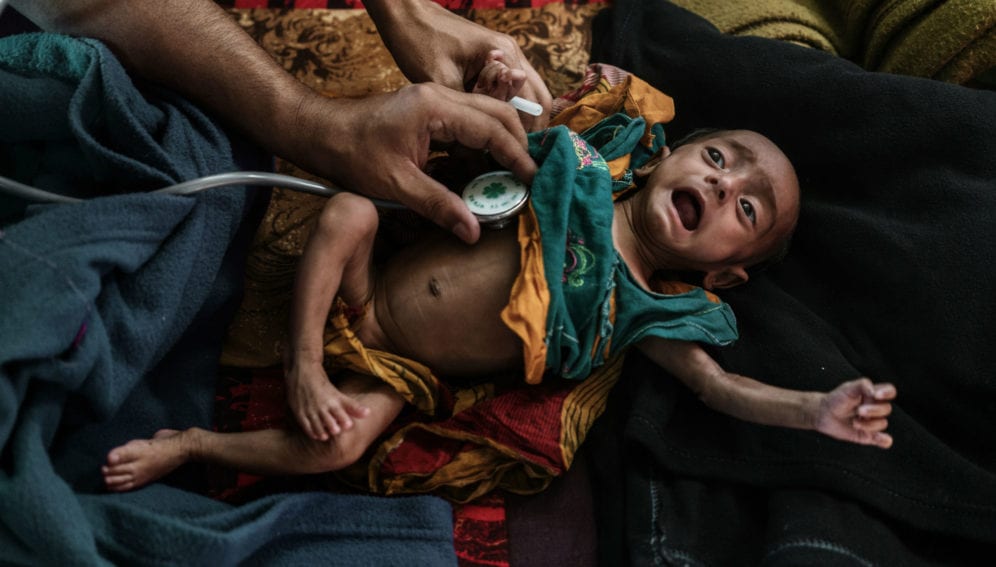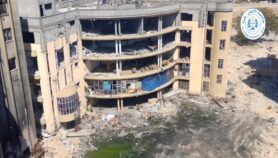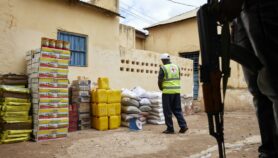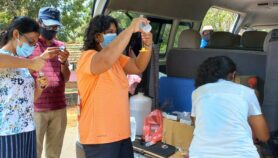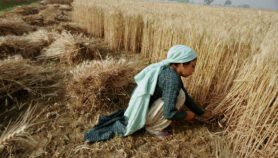By: Adel Aldaghbashy
Send to a friend
The details you provide on this page will not be used to send unsolicited email, and will not be sold to a 3rd party. See privacy policy.
[SANAA, YEMEN] Thousands of starving Yemenis have nothing to eat except tree leaves and wild mountain plants – leading the UN to warn of unknown health impacts.
Yemen has more people in stage five of the Global Food Security Index, the worst level of food availability, than any other country on the planet. Mark Lowcock, UN under-secretary-general for humanitarian affairs and emergency relief coordinator, said the country’s situation was worse than South Sudan, where around 25,000 people are estimated to suffer from stage-five food insecurity.
“250,000 people in Yemen are already in the fifth stage,” Lowcock says. “This is crisis level; there are no more stages in the Global Food Security Index.”
Internationally enabled civil war has raged in Yemen since 2015. Food supply in many areas like Al-Hajjah, Al-Muhweet, Al-Hudaydah and Taiz governorates, are now so bad that locals are forced to resort to eating plants. These include local vines such as Hallas (Cissus rotundifolia), Rumex nervosus Vahl, Orbea wissmannii, and Cyphostemma digitatum.
One of Al-Muhweet’s inhabitants, 70-year-old Abdou Alhaj, told SciDev.Net that his people are eating plants that are not scientifically recognised – known locally as Al-Batha, Bent Al-Weshah and Zangabilet Al-Agouz. Many inhabitants in the districts of Aslam, Beni Saad, Al-Tahta, Zubaid, Al-Mokha and Mawza cook these plants for lunch and dinner, while the poorest eat them raw.
“250,000 people in Yemen are already in the fifth stage. This is crisis level; there are no more stages in the Global Food Security Index.”
Mark Lowcock, UN
In one poor neighbourhood in the capital Sanaa, Mohammed Ka’ed sells Halas and Cyphostemma digitatum for US$1.5 per kilo. “The demand is increasing, and it is mostly before midday that I finish the whole sack for US$4 to US$8,” he says.
Ka’ed is originally from the Eb governorate south of Sanaa. He explains how the plants are cooked. “A soup is made from Halas leaves with pepper and milk, or otherwise, mixed with flour, and served as a meal.”
But there is little scientific information on the effect these plants have on human bodies when digested. Marwan Mokbel, a technician at the Yemen Geological Survey and Mineral Resources Board, has examined the plants in his laboratory. He says that they contain plenty of minerals, such as phosphate, magnesium and potassium.
“Results also show that some of them have medicinal use”, Mokbel says. He points out that the nutritious value of the plants is still unknown.
Mansoor Mohamed Alakel, the chairman of Yemen’s Agricultural Research and Extension Authority (AREA), described existing classification of these plants as “unmethodical”, and said he would categorise them as aromatic plants. Alakel underlined that there have been no studies so far to analyse the components of these trees or their nutritious characteristics.
Providing basic nutrition for starving Yemenis for the coming year requires funding worth around US$3 billion, according to the UN. A high-level conference, scheduled to take place in February 2019, is meant to hammer out a humanitarian response plan for the crisis.
Meanwhile, efforts continue in the country to understand the health impact the regular ingestion of leaves will have on Yemen’s population. The country’s deputy minister of agriculture and irrigation, Majeed Al-Mutawakel, says that one problem is that these plants are not recognised as part of the food chain. As a result, they are beyond the scope of most of the country’s nutritionists.
“This is because most studies are about food resources and promoting production,” he explains. “What we know about these plants, is that they have been used as a source for food at the time of famine that took place in the first half of the twentieth century.”
Wafaa Nasher, an adviser on food industries at the ministry of agriculture and irrigation, says: “We have studies that explored these plants within the realm of medicinal and aromatic characteristics, but we didn’t address them as food. This has only occurred with Halas and Cyphostemma digitatum, even though they are still perceived as secondary or complementary foods.”
Nasher continued: “According to my knowledge, these plants contain good nutritious elements, I just didn’t find any studies that elaborate on their content or composition in details.”
Yemen’s population numbers around 27 million. The country is the poorest in the Middle East, with a per-capita GDP of just $1,300 a year. The food crisis stems from a Saudi Arabia-imposed import blockade of food and medicines, which was created to starve rebel Houthi fighters of resources, but has caused unspeakable human suffering. In 2017, around 50,000 Yemeni children died of starvation, which numbers for 2018 expected to be around the same, if not higher.
Alhaj, the Al-Muhweet local, says that Halas leaves should be filtered after boiling them, and that only the juice should be used. His advice results from an unknown disease observed locally in people eating remnants of boiled leaves, where they experience swellings beneath the eyes and abdominal inflation. Some eventually die within days.But Nasher, the government adviser, says she had not heard of such cases. However, she still asserts that depending only on theses plants will severely increase malnutrition problems in Yemen, especially among children. “These plants shouldn’t be the only source of food; but [be consumed] among other foods,” she says.
This piece was produced by SciDev.Net’s Middle East & North Africa desk.


